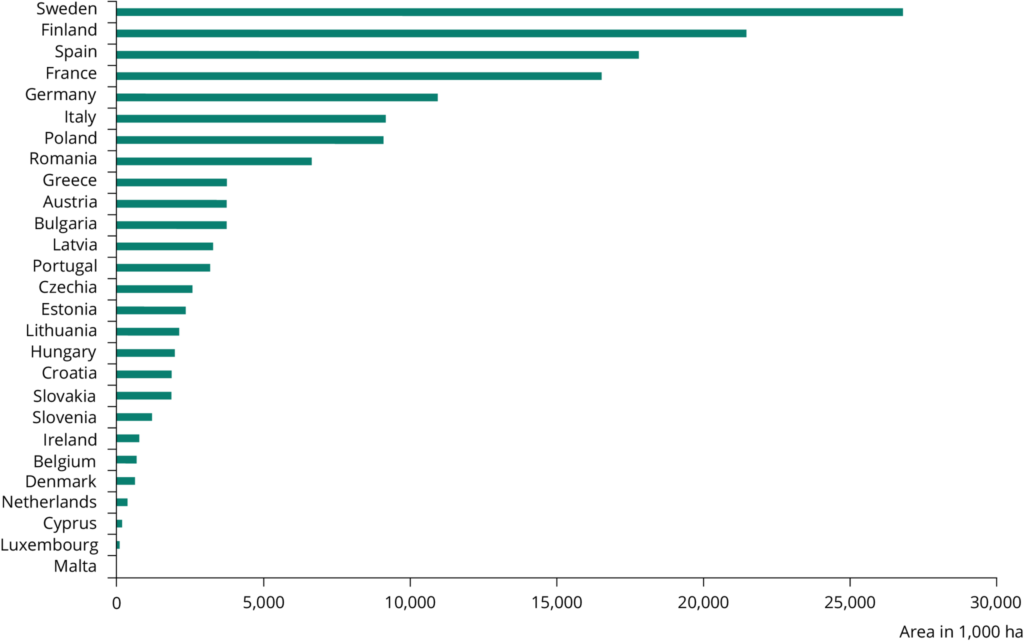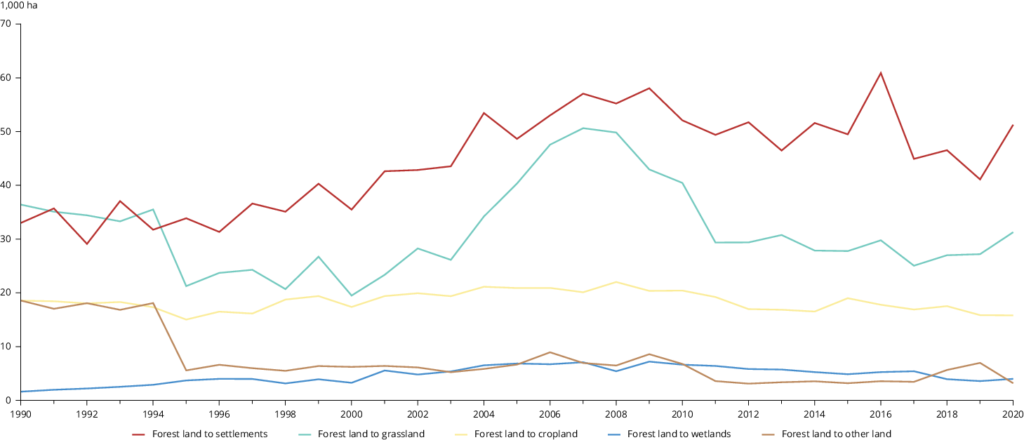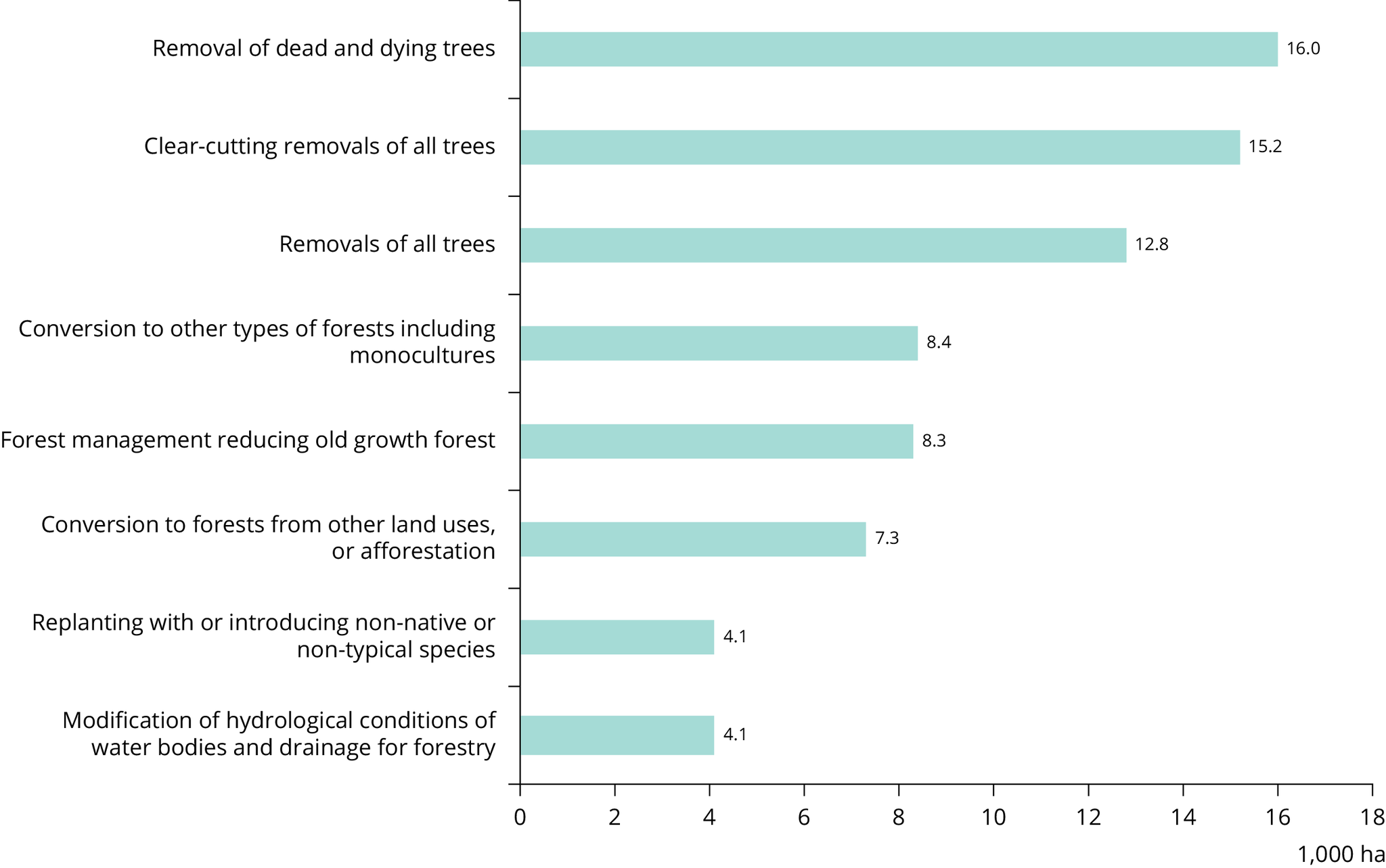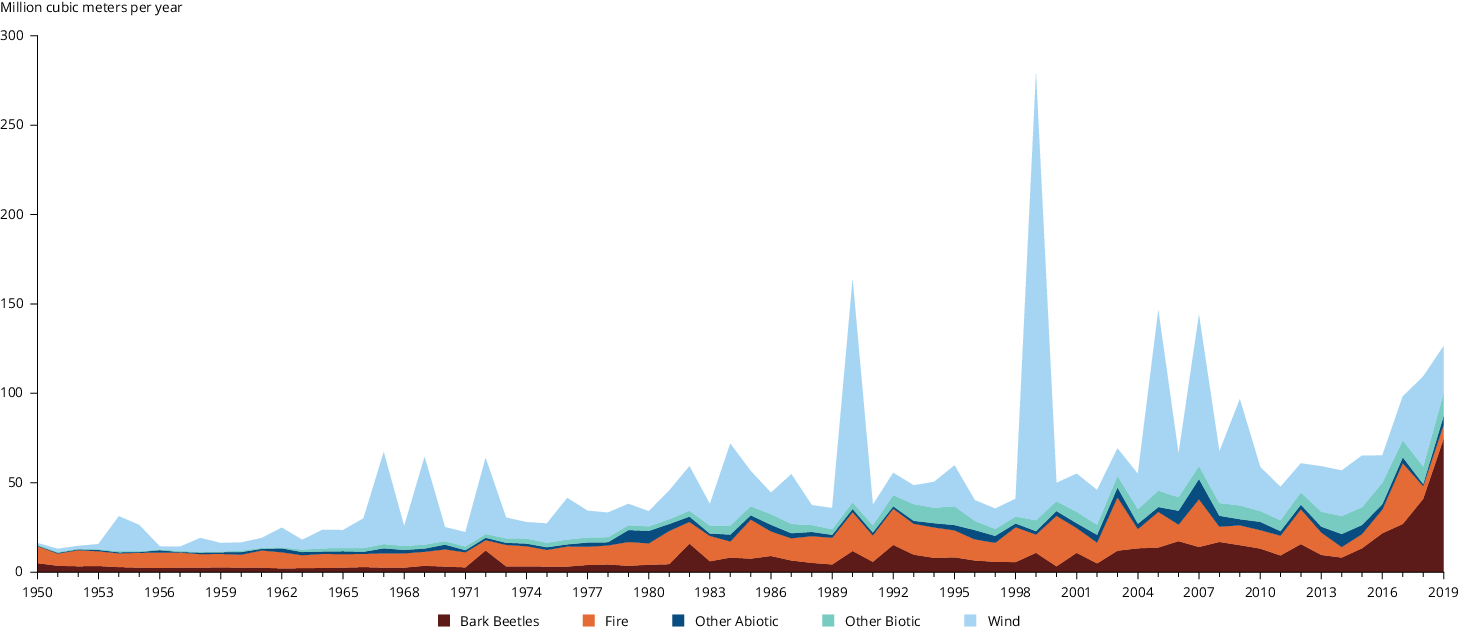The fundamental and changing value of forests
Forest ecosystems are a precious resource. Hosting biodiversity, purifying air and water, and supplying livelihoods for communities are among their many benefits for society and well-being.
Approximately 10% of the EU-27’s annual greenhouse gas emissions are absorbed and stored in forest soils and biomass. In addition, forests substantially influence microclimate regulation by affecting temperature, humidity, moisture availability and light conditions. For example, recent studies show that temperatures in European forests are, on average, 2.1°C lower in summer and 2.0°C degrees warmer in winter than their surrounding environments; in the summer, differences can go up to 10°C between forests and adjacent urban areas (Haesen et al., 2021). Forests are essential for mitigating the harmful effects of climate change, including heavy precipitation events, extended droughts and pest outbreaks.
Forests interact closely with their soils: for example, forests prevent soil erosion, enhance water storage, and moderate air and soil temperatures. Likewise, soils are crucial for forest biodiversity and support tree growth with essential water and nutrient cycling.
European forests are a resource base for various economic sectors and local communities because they supply timber, fibre, fuelwood, food and cork. Beyond their support and regulating services, forests are essential to society, supplying materials and providing services. Importantly, forests also have non-material value for people, including spiritual enrichment and recreation.
European forests’ continued ability to provide society with the required ecosystem services significantly depends on climate change, and societal choices and actions. Given trees’ longevity, these decisions will need a long-term perspective that reaches beyond the 2050 horizon and encompasses the role of forests in preserving biodiversity and climate action.
Forests in the EU-27 — current state and trends
Forests constitute the largest terrestrial ecosystem in the EU-27, extending to around 160 million hectares (FAO, 2020). Forest extent is not evenly distributed between Member States (Figure 1). Two-thirds of forests are in six Member States (Sweden, Finland, Spain, France, Germany and Poland). The net total forest area has increased by almost 10% since 1990. This increase has slowed in recent years, primarily due to a decrease in agricultural land converted to forest. Whereas global deforestation is caused by converting forests to agriculture, deforestation in Europe is mainly caused by urban development and the conversion of forests to agricultural land (European Parliament, 2022) (Figure 2).
Figure 1. Forest area in the EU-27, 2020

Figure 2. Area of annually deforested land in the EU-27, 1990-2020

Forest types, composition and structure
Europe’s forests represent a variety of ecosystems generated by differences in climate, topography, soils, disturbances, use and management. Most European forests have been managed and modified, transforming their extent, structure, species composition and functions. Nevertheless, some characteristics of natural forest vegetation remain in the forest distribution range, i.e. European beech (Fagus sylvatica) woodlands in central Europe, different oak (Quercus) woodlands in the Mediterranean region or coniferous forests and taiga in northern Europe. This is also reflected in, for example, the 14 forest categories of the European Forest Type scheme that aggregate 78 European forest types (EEA, 2006). Similarly, the European Nature Information System (EUNIS) habitat classification identifies 44 main forest habitat types and various other subtypes (EEA, 2019).
Europe’s original natural vegetation was forest, covering more than 80% of the land. Currently, forests across the EU Member States are predominantly semi-natural (more than 90%) and mainly planted. This explains why the majority (60%) are composed of even-aged trees (Forest Europe, 2020) and why one-third have only one species (Forest Europe, 2020). The monocultural characteristics may be due to intense management or the characteristics of a particular tree species, such as boreal pine forests or beech forests that dominate and have poor understorey vegetation. The remaining forests are either plantations (3%) or primary and old-growth forests (2%) (Forest Europe, 2020). This leaves minimal area for forests with natural composition, structure and functions. Primary and old-growth forests are of utmost importance for Europe’s biodiversity since they are more stable, resistant and adaptive to disturbances than modified forests. Furthermore, they host several endangered species and provide complex microhabitats for many species due to higher volumes of deadwood and their complex structure (EEA, 2016). Protecting these rare and unique forests is essential for biodiversity preservation and climate change mitigation. Nevertheless, the number of tree species in European forests is increasing. More than half of the forests in the 21 countries reporting the number of tree species have two or three, and more than four species cover almost 16% of the forest area (Forest Europe, 2020).
Increasing the biodiversity of planted and semi-natural forests will positively affect these forests’ resilience and capacity to capture and store carbon. Possible solutions require integrated approaches considering the pressures and impacts affecting forest ecosystems.
Increasing pressures on Europe’s forests
Today, forest ecosystems in Europe face direct and indirect pressures that threaten their functions by increasing their vulnerability to disturbances. Forest ecosystems face an increase in the frequency, intensity and scale of extreme weather events (e.g. droughts, flooding, heatwaves, windstorms and frost). These events weaken trees, making them more susceptible to insect pests and other disturbances. Ultimately, this could degrade their ability to sustain ecosystem functions and supply critical benefits (i.e. drinking water) and to moderate extreme weather impacts, such as flooding from heavy rainfall (Maes et al., 2020).
The conversion of forests to other land use, overexploitation of species, invasive alien species, infestations and pests, pollution and climate change are all contributing factors. Many impacts are interrelated; for example, drought and fires may catalyse infestations. The European Ecosystems Assessment (Maes et al., 2020) identified key pressures on forest ecosystems (Table 1).
Table 1. Key pressure trends on aggregated pressure indicators
| Key pressure group | Main findings at EU level |
|---|---|
| Habitat conversion and degradation | Mixed trends. Forest cover change and forest fragmentation stable, forest land take positive, tree cover loss negative — but significant lasting effects from historical degradation. |
| Climate change impacts | Almost exclusively negative short- and long-term trends. Some uncertainties about trends in key indicators. |
| Pollution and nutrient enrichment | Positive trends for all three key indicators (ozone, acidification and nutrients) but exceedance of critical loads in a significant share of forests. |
| Overexploitation | Unresolved short-term trends and stable long-term trends. |
| Invasive alien species | Poor data availability. |
| Pests and insect infestations | Poor data availability. |
| Soil erosion | Poor data availability. |
Source: Compiled from Maes et al. (2020), table 3.3.4.
The EEA State of nature in the EU report (EEA, 2020) describes increased pressures on Annex 1 forest habitats from intensified forest practices, such as the removal of dead and dying trees and the clear-cutting and removal of old trees. It also describes indirect impacts, such as the modification of the water regime in an ecosystem (Figure 3).
Figure 3. Eight most relevant reported pressures from forestry on forest habitats and species, 2013-2018

Source: EEA (2020).
Explore different chart formats and data here
While land use change is currently the most significant threat to forests, climate change is expected to overtake it at local and regional scales. The frequency and intensity of several natural disturbances, such as unprecedented bark beetle outbreaks, drought damage and wildfire dynamics, have significantly increased in the last 70 years. Windthrow is the most significant disturbance, followed by fire (Figure 4). Insect outbreaks recurred periodically until 2000, after which their magnitude increased dramatically. For instance, bark beetle infestations doubled their share of damage over the last 20 years. Similarly, the disturbances caused by fires have increased significantly across Europe. The wildfire season in summer 2022 was exceptional. The European Forest Fire Information System (EFFIS) detected a number of fires larger than the long-term average for 2006-2021 and larger than the earlier maximum values since the start of the EFFIS data record in 2006 (European Commission, 2022).
Approximately 130,000 hectares were burned in south and south-west France, northern Spain and Portugal. Factors enhancing fire activity in the area were the heatwaves experienced in July and August combined with severe drought, which led to dangerously elevated fire risk. These fires also led to exceptional emissions, such as accumulated carbon monoxide concentrations. Furthermore, no matter how remote, all forests respond to increasing concentrations of CO2 and climate change.
The increased demand for forest biomass is expected to affect forests adversely. Recent studies have called for a ‘course correction’ to the use of biomass for energy and a ‘precautionary approach’ that considers the possible trade-offs between biomass production and biodiversity.
Figure 4. Total reported damage caused by disturbances in Europe between 1950 and 2019

Source: Patacca et al. (2022).
Explore different chart formats and data here
Implementing measures to protect and restore Europe’s forests, such as sustainable forest management, restoring degraded forests and protecting forests from invasive alien species and pests, is essential. Additionally, reducing greenhouse gas emissions and addressing climate change are crucial to protecting the health of forests in Europe and the rest of the world. The destruction of forest habitats and ecosystems and the subsequent decrease in forest carbon sinks may compromise European climate and biodiversity targets.
An urgency to act
The European Green Deal positions forests as key to reaching its objectives. The EU biodiversity strategy for 2030 and the EU forest strategy for 2030 call for improving forest extent and quality, strictly protecting primary and old-growth forests, promoting reforestation, and afforestation with the right trees at the right time and in the right place. The complexity of forests and their use means integrated approaches are required to avoid possible trade-offs; for example, between biodiversity and wood extraction or climate change mitigation.
However, there are ways to enable action. These include securing policy coherence (e.g. coordinating several policy areas involving forests, biodiversity, climate change, bioeconomy and energy, as proposed in the EU forest strategy); reinforcing nature-based solutions to protect, restore and maintain sustainable forests; and having secure access to timely and up-to-date information on forests to improve knowledge and decision-making.
The following information, documents, and materials were originally published by the European Environment Agency (EEA) and are being shared on this platform with the EEA’s permission. The EEA holds the rights of use for this material, and it may be reused by others without prior permission, provided that the EEA is acknowledged as the original source and the original meaning or message of the content is not distorted.







